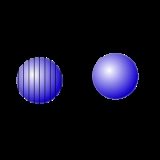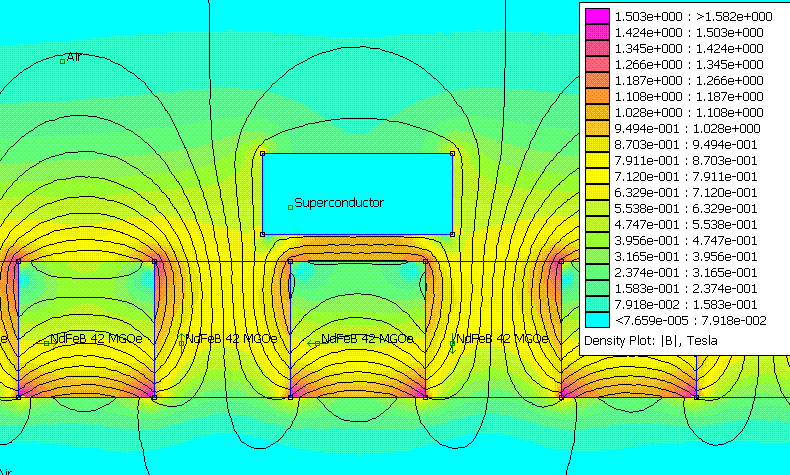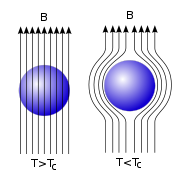
Superdiamagnetism
Encyclopedia

Phenomenon
A phenomenon , plural phenomena, is any observable occurrence. Phenomena are often, but not always, understood as 'appearances' or 'experiences'...
occurring in certain materials at low temperatures, characterised by the complete absence of magnetic permeability (i.e. a magnetic susceptibility
Magnetic susceptibility
In electromagnetism, the magnetic susceptibility \chi_m is a dimensionless proportionality constant that indicates the degree of magnetization of a material in response to an applied magnetic field...
 = −1) and the exclusion of the interior magnetic field
= −1) and the exclusion of the interior magnetic fieldMagnetic field
A magnetic field is a mathematical description of the magnetic influence of electric currents and magnetic materials. The magnetic field at any given point is specified by both a direction and a magnitude ; as such it is a vector field.Technically, a magnetic field is a pseudo vector;...
. Superdiamagnetism is a feature of superconductivity
Superconductivity
Superconductivity is a phenomenon of exactly zero electrical resistance occurring in certain materials below a characteristic temperature. It was discovered by Heike Kamerlingh Onnes on April 8, 1911 in Leiden. Like ferromagnetism and atomic spectral lines, superconductivity is a quantum...
. It was identified in 1933, by Walter Meissner and Robert Ochsenfeld
Robert Ochsenfeld
Robert Ochsenfeld was a German physicist born on May 18, 1901 in Hilchenbach . In 1933 he discovered with Walter Meissner the Meißner-Ochsenfeld effect.He died on December 5, 1993 in Hilchenbach....
(the Meissner effect
Meissner effect
The Meissner effect is the expulsion of a magnetic field from a superconductor during its transition to the superconducting state. The German physicists Walther Meissner and Robert Ochsenfeld discovered the phenomenon in 1933 by measuring the magnetic field distribution outside superconducting tin...
).
Superdiamagnetism established that the superconductivity of a material was a stage of phase transition
Phase transition
A phase transition is the transformation of a thermodynamic system from one phase or state of matter to another.A phase of a thermodynamic system and the states of matter have uniform physical properties....
. Superconducting magnetic levitation is due to superdiamagnetism, which repels a permanent magnet, and flux pinning
Flux pinning
Flux pinning is the phenomenon that magnetic flux lines do not move in spite of the Lorentz force acting on them inside a current-carrying...
, which prevents the magnet floating away.

Theory
Fritz LondonFritz London
Fritz Wolfgang London was a German theoretical physicist. His fundamental contributions to the theories of chemical bonding and of intermolecular forces are today considered classic and are discussed in standard textbooks of physical chemistry.With his brother Heinz, he made a significant...
and Heinz London
Heinz London
Heinz London was a German Physicist. He worked with his brother Fritz on superconductivity, discovering the London equations when working in Oxford, at the Clarendon Laboratory; these equations gave a first explanation to the Meissner effect...
developed the theory that the exclusion of magnetic flux
Magnetic flux
Magnetic flux , is a measure of the amount of magnetic B field passing through a given surface . The SI unit of magnetic flux is the weber...
is brought about by electrical screening currents that flow at the surface of the superconducting material and which generate a magnetic field
Magnetic field
A magnetic field is a mathematical description of the magnetic influence of electric currents and magnetic materials. The magnetic field at any given point is specified by both a direction and a magnitude ; as such it is a vector field.Technically, a magnetic field is a pseudo vector;...
that exactly cancels the externally applied field inside the superconductor. These screening currents are generated whenever a superconducting material is brought inside a magnetic field. This can be understood by the fact that a superconductor has zero electrical resistance, so that "eddy current
Eddy current
Eddy currents are electric currents induced in conductors when a conductor is exposed to a changing magnetic field; due to relative motion of the field source and conductor or due to variations of the field with time. This can cause a circulating flow of electrons, or current, within the body of...
s", induced by the motion
Motion (physics)
In physics, motion is a change in position of an object with respect to time. Change in action is the result of an unbalanced force. Motion is typically described in terms of velocity, acceleration, displacement and time . An object's velocity cannot change unless it is acted upon by a force, as...
of the material inside a magnetic field, will not decay. Fritz, at the Royal Society
Royal Society
The Royal Society of London for Improving Natural Knowledge, known simply as the Royal Society, is a learned society for science, and is possibly the oldest such society in existence. Founded in November 1660, it was granted a Royal Charter by King Charles II as the "Royal Society of London"...
in 1935, stated that the thermodynamic state would be described by a single wave function.
"Screening currents" also appear in a situation wherein an initially normal, conducting metal is placed inside a magnetic field. As soon as the metal is cooled below the appropriate transition temperature, it becomes superconducting. This expulsion of magnetic field upon the cooling of the metal cannot be explained any longer by merely assuming zero resistance and is called the Meissner effect
Meissner effect
The Meissner effect is the expulsion of a magnetic field from a superconductor during its transition to the superconducting state. The German physicists Walther Meissner and Robert Ochsenfeld discovered the phenomenon in 1933 by measuring the magnetic field distribution outside superconducting tin...
. It shows that the superconducting state does not depend on the history of preparation, only upon the present values of temperature
Temperature
Temperature is a physical property of matter that quantitatively expresses the common notions of hot and cold. Objects of low temperature are cold, while various degrees of higher temperatures are referred to as warm or hot...
, pressure
Pressure
Pressure is the force per unit area applied in a direction perpendicular to the surface of an object. Gauge pressure is the pressure relative to the local atmospheric or ambient pressure.- Definition :...
and magnetic field, and therefore is a true thermodynamic state
Thermodynamic state
A thermodynamic state is a set of values of properties of a thermodynamic system that must be specified to reproduce the system. The individual parameters are known as state variables, state parameters or thermodynamic variables. Once a sufficient set of thermodynamic variables have been...
.

